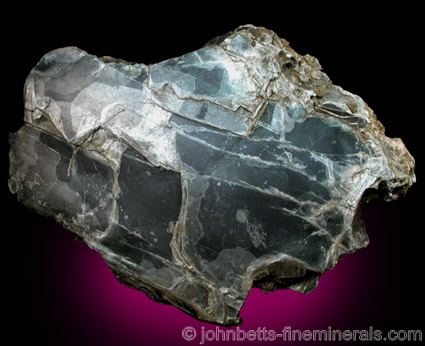The Mineral clinochlore

Clinochlore is a member of the Chlorite group and is one of the better-known members. It most often is an uninteresting matrix for more important minerals, but the rare and beautiful pink to red variety Kammererite is very popular and treasured by collectors.
Clinochlore forms a series with the Chamosite within the Chlorite group. Chamosite is the iron rich end member, and Clinochlore is the magnesium-rich end member. Their properties are very similar, and they are difficult to
distinguish from each other, though Clinochlore is softer, lighter, and
usually more transparent than Chamosite.
Chemical Formula
(Mg,Fe2+)5Al2Si3O10(OH)8
Color
Light to dark green, pink, red, purple, yellow, gray, brown, white, black
Crystal System
Monoclinic
Properties
Streak
White |
Hardness
2 - 2.5 |
Transparency
Transparent to translucent |
Specific Gravity
2.55 - 3.0 |
Luster
Vitreous to pearly |
Cleavage
1,1 |
Fracture
Uneven |
Tenacity
Thin flakes are flexible but not elastic. |
Other ID Marks
May have a slightly greasy feel. |
Varieties
-
Chromium-rich variety of Clinochlore with a pink to deep crimson-red color. Also spelled Kämmererite or Kaemmererite.
Uses
The pink to purple chromium-rich variety of Kammererite is a rare and popular collectors mineral.
Noteworthy Localities
Noteworthy locations include the Korshunovskoye mine, Zheleznogorsk, Russia; the Fee Glacier in the Saas Valley, Wallis, Switzerland; the Zillertal, Tyrol, Austria; and Val Malenco, Sondrio, Italy.
The most famous locality for Kammererite is the Kop Krom mine, Kop Daglari, Erzurum, Turkey; where it comes in transparent gemmy crystals of deep and beautiful crimson color. Kaemmererite also comes from Turkey at Guleman, Elazig.
In the U.S., the original type locality is Brinton's Quarry, West Chester, Chester County, Pennsylvania. Other localities are the Old Mine Plaza, Trumbull, Fairfield Co., Connecticut; the New Idria District in the Diablo Range, San Benito Co., California; and the Jeffrey mine, Asbestos, Quebec, Canada.
Exceptional Clinochlore crystals came from the old Tilly Foster mine, Brewster, Putnam Co., New York, sometimes in strange pseudomorphs after other minerals. Excellent pseudomorphs of Chlorite after Garnet come from Michigamme, Marquette Co., Michigan. A classic Kammererite locality in the U.S. is the Wood's Chrome Mine, Texas, Lancaster Co., Pennsylvania.
Distingushing Similar Minerals
Muscovite and other micas - Are more elastic then Chlorites.
Talc - Softer (1).
Other Chlorite minerals - Indistinguishable by practical methods.